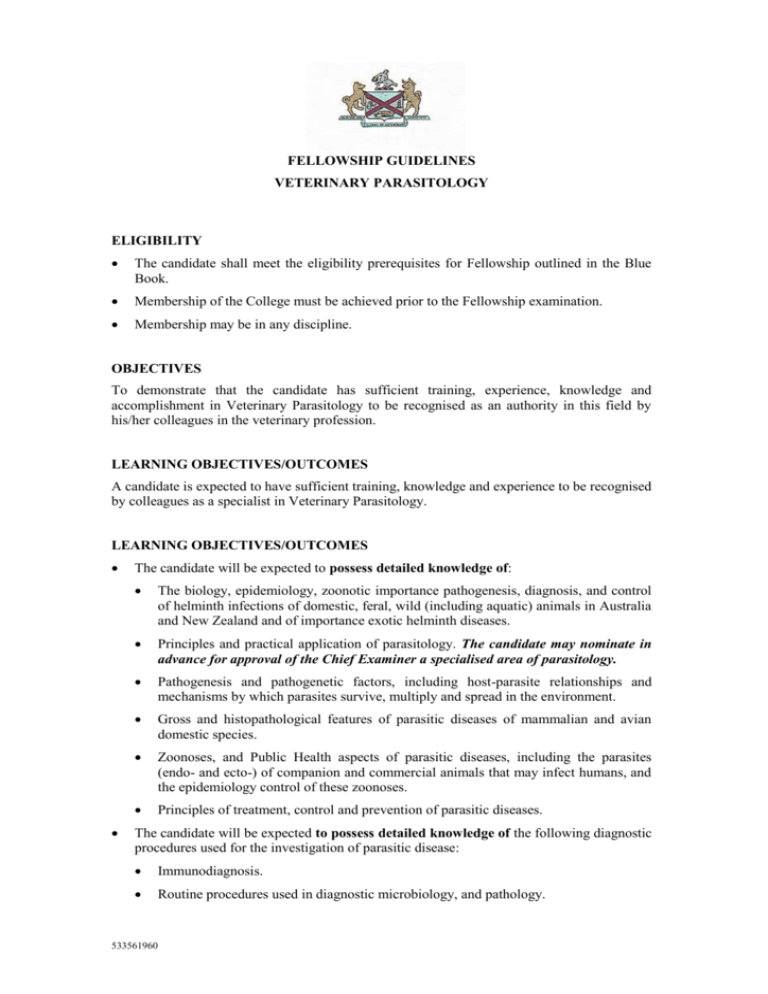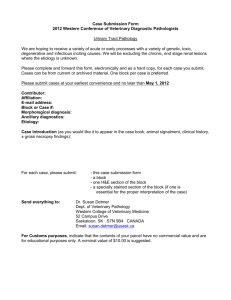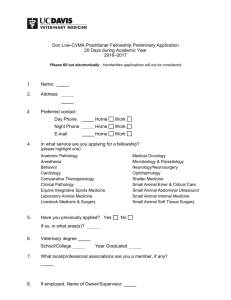activity log categories
advertisement

FELLOWSHIP GUIDELINES VETERINARY PARASITOLOGY ELIGIBILITY The candidate shall meet the eligibility prerequisites for Fellowship outlined in the Blue Book. Membership of the College must be achieved prior to the Fellowship examination. Membership may be in any discipline. OBJECTIVES To demonstrate that the candidate has sufficient training, experience, knowledge and accomplishment in Veterinary Parasitology to be recognised as an authority in this field by his/her colleagues in the veterinary profession. LEARNING OBJECTIVES/OUTCOMES A candidate is expected to have sufficient training, knowledge and experience to be recognised by colleagues as a specialist in Veterinary Parasitology. LEARNING OBJECTIVES/OUTCOMES The candidate will be expected to possess detailed knowledge of: The biology, epidemiology, zoonotic importance pathogenesis, diagnosis, and control of helminth infections of domestic, feral, wild (including aquatic) animals in Australia and New Zealand and of importance exotic helminth diseases. Principles and practical application of parasitology. The candidate may nominate in advance for approval of the Chief Examiner a specialised area of parasitology. Pathogenesis and pathogenetic factors, including host-parasite relationships and mechanisms by which parasites survive, multiply and spread in the environment. Gross and histopathological features of parasitic diseases of mammalian and avian domestic species. Zoonoses, and Public Health aspects of parasitic diseases, including the parasites (endo- and ecto-) of companion and commercial animals that may infect humans, and the epidemiology control of these zoonoses. Principles of treatment, control and prevention of parasitic diseases. The candidate will be expected to possess detailed knowledge of the following diagnostic procedures used for the investigation of parasitic disease: Immunodiagnosis. Routine procedures used in diagnostic microbiology, and pathology. 533561960 2 For internal parasites (nematodes, cestodes, trematodes, protozoans), the candidate will be expected to be able to: Name, describe and identify the common internal parasites and diagnose the internal parasitoses of the common companion and commercial animal species. Apply basic parasitological knowledge and, using standard identification keys and texts, identify unusual internal parasites in the common companion and commercial animals, and parasites in uncommon companion and commercial animals. Know where to seek help in the identification of internal parasites from zoo animals and wildlife. Examine faeces or urine from companion or commercial animals for parasites, using standard techniques, and identify any parasitic structures present and their origins. Using basic principles, identify similar structures in the faeces and urine of other animals. Examine a blood sample from an animal and identify intra- and intercellular parasites using routine methods including immunological tests where commercially available. Carry out a routine necropsy on a common companion or commercial animal and, using standard methods, recover helminths present in the gastro-intestinal tract, liver or lungs, identify the parasites, and estimate the total population and percentage of individual species. Remove and preserve suitable samples of organs for histopathology and identify parasites in stained tissue sections. For ectoparasites (insects, arachnids), the candidate will be expected to be able to: Name, describe and identify the common ectoparasites, and diagnose the ectoparasitoses of the common companion and commercial animals. Apply basic parasitological knowledge and, using standard identification keys and texts, identify unusual ectoparasites of the common animals, and ectoparasites of uncommon companion and commercial animals. Examine an animal for ectoparasites and identify the parasites using routine methods and immunological tests where available. Know where to seek help in the identification of ectoparasites on zoo animals and wildlife. In the application of parasitological knowledge, the candidate will be expected to be able to: Explain the epidemiology of the parasitosis and suggest appropriate treatment and control measures, given the history of a parasitic situation, the results of clinical examination and parasitological tests including, where appropriate, necropsy findings. Define the extent of a parasitic problem, plan and carry out the investigation, and report findings in writing, using concise and grammatical English and an approved style of citation and referencing. Apply appropriate tests to identify or confirm anthelmintic resistance in helminth parasites of farm animals or horses. Based on the results of the tests and knowledge of the management system, suggest alternative control measures for farms and horse establishments. Explain, using examples, the role of epidemiological models in predicting outbreaks of, and controlling, parasitic disease. Survey the prevalence of parasites in a discrete population, compare prevalence in two or more discrete populations, and determine the geographical distribution of parasites in a dispersed population using appropriate parasitological and statistical methods. 3 Identify the need for parasitological information, obtain and evaluate the information from the appropriate printed material, databases and electronic resources. Respond to the need of the veterinary profession or public for information and advice on parasitic infections in domestic animals, including poultry and caged birds, by communication in an appropriate medium using concise and effective language. EXAMINATIONS Refer to the Blue Book. TRAINING PROGRAMS Refer to the Blue Book TRAINING IN RELATED DISCIPLINES Refer to the Blue Book Candidates for Fellowship in Veterinary Parasitology must spend time as stipulated by the Blue Book in any or all of the following related disciplines: clinical pathology, microbiology, immunology, toxicology, parasitology, epidemiology and clinical medicine EXTERNSHIPS Refer to the Blue Book ACTIVITY LOG CATEGORIES Refer to the Blue Book The Activity Log should be recorded in a format similar to the example in Blue Book Appendix E-2. The Activity Log Summary should be divided by BOTH body system AND species. See the examples in Blue Book Appendix F-1 and F-2. RECOMMENDED READING LIST The candidate is expected to research the depth and breadth of the knowledge of the discipline. This list is intended to guide the candidate to some core references and other resource material. The list is not comprehensive and is not intended as an indicator of the content of the examination. Books Animal Health in Australia: Vol. 5 (1984) Protozoal and Rickettsial Diseases (IL Callow). Vol. 8 (1986) Helminth Parasites of Sheep and Cattle (VG Cole). Reviews, University of Sydney, Post Graduate Committee in Veterinary Science:No.17 (1977) Canine Parasitology (Kelly J). No.24 (1984) Parasitic Diseases of the Cat in Australia (Prescott). No.26 (1985) Veterinary Anthelmintics (Arundel JH). No.28 (1985) Parasitic Diseases of the Horse (Arundel JH). 4 No 31 (1990) Clinical Parasitology of Dogs (Dunsmore JD, Shaw SE). No 32 (1995) Parasites of Cattle (Smeal MG) Adam KMG, Paul J, Zaman V (1971) Medical and Veterinary Protozoology, An Illustrated Guide Churchill Livingstone, Edinburgh. Albiston HE (1967) Diseases of Domestic Animals in Australia Part2 Arthropod Infestations (Flies, Lice and Fleas) Commonwealth of Australia, Department of Health. Collins GH Veterinary Parasitology 3 and 4 (Current Edition) Faculty of Veterinary Science, University of Sydney. (Manuals prepared for undergraduate veterinary students). Dunn AM (1978) Veterinary Helminthology William Heinemann Medical Books Ltd, London. Geering WA, Forman AJ, Nunn MJ (1995) Exotic Diseases of Animals. A Field Guide for Australian Veterinarians. Australian Government Publishing Service, Canberra. Georgi JR (1985) Parasitology for Veterinarians WB Saunders, Philadelphia. Manual of Veterinary Parasitological Techniques Reference Book 418 (1971) Ministry of Agriculture and fisheries and Food, Her Majesty’s Stationary Office, London. Roberts FR (1970) Australian Ticks CSIRO. Sloss MW, Kemp RL (1978) Veterinary Clinical Parasitology 5th Edition Iowa State University press Ames, Iowa. Soulsby EJL (1962) Helminths, Arthropods and Protozoa of Domestic Animals (6th Edition of Monnig’s Veterinary Helminthology & Entomology) Balliere, Tyndall Cassell, London. Soulsby EJL (1965) Textbook of Veterinary Clinical Parasitology Volume 1 Helminths Blackwell Scientific Publications, Oxford. Thienpont D, Rochette F, Vanparijs OFJ (1979) Diagnosing Helminthiasis through Coprological Examination Jansen Research Foundation. Whitlock JH (1960) Diagnosis of Veterinary Parasitisms Lea & Febiger, Philadelphia. Buxton A, Fraser G (1977) Animal Microbiology Blackwell Scientific Publications, Oxford. Carlton WW, McGavin MD (1995) Thomson’s Special Veterinary Pathology second Edition. Cotran RS, Kumar V. Robbins SL Robbins Pathological Basis of Disease WB Saunders, Philadelphia. Jubb KVF, Kennedy PC, Palmer N Pathology of Domestic Animals Academic Press, San Diego. Quinn PJ, Carter, ME, Markey B, Carter GR (1994) Clinical Veterinary Microbiology Mosby, Edinburgh; Harcourt Publishers Ltd. Slauson DO, Cooper BJ (1982), Mechanisms of Disease Williams & Wilkins, Baltimore. * Thomson R (1984) General Veterinary Pathology 2nd Edition. WB Saunders, Philadelphia.* Fish Diseases: Proceedings 106 Refresher Course for Veterinarians, Post Graduate Committee in Veterinary Science, 23-27 May 1988. Humphrey JD, Langdon JS (1985) Diseases of Australian Fish and Shellfish Proceedings of Workshop Australian Fish Health Reference Laboratory, Regional Veterinary laboratory, Benalla 27-30 May 1985. Noga EJ (1996) Fish Disease. Diagnosis and Treatment Mosby-Year Book Inc, Missouri. 5 Roberts RJ (2001) Fish Pathology 3rd Edition.WB Saunders London. Journals (particularly of the immediate past 5 years). American Journal of Veterinary Research.* Australian Veterinary Journal.* NZ Veterinary Journal.* Research in Veterinary Science. Veterinary Pathology. Journals for Review Articles Immunology Today.* New England Journal of Medicine.*








